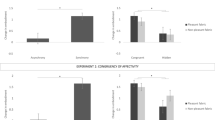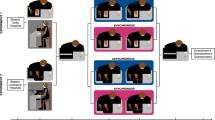Abstract
Research has suggested that altering the perceived shape and size of the body image significantly affects perception of somatic events. The current study investigated how multisensory illusions applied to the body altered tactile perception using the somatic signal detection task. Thirty-one healthy volunteers were asked to report the presence or absence of near-threshold tactile stimuli delivered to the index finger under three multisensory illusion conditions: stretched finger, shrunken finger and detached finger, as well as a veridical baseline condition. Both stretching and shrinking the stimulated finger enhanced correct touch detections; however, the mechanisms underlying this increase were found to be different. In contrast, the detached appearance reduced false touch reports—possibly due to reduced tactile noise, as a result of attention being directed to the tip of the finger only. These findings suggest that distorted representations of the body could have different modulatory effects on attention to touch and provide a link between perceived body representation and somatosensory decision-making.



Similar content being viewed by others
Notes
During the veridical baseline condition, participants were only presented with questionnaire items that measured sense of ownership towards their hand, as no illusion was presented.
This was only conducted in conditions with a multisensory illusion. Participants were still given a break during the veridical condition.
References
Barsky A, Goodson J, Lane R, Cleary P (1988) The amplification of somatic symptoms. Psychosom Med 50(5):510–519
Barsky A, Wyshak G, Klerman G (1990) The somatosensory amplification scale and its relationship to hypochondriasis. J Psychiatr Res 24(4):323–334
Botvinick M, Cohen J (1998) Rubber hands ‘feel’ touch that eyes see. Nature 391:756
Bruno N, Bertamini M (2010) Haptic perception after a change in hand size. Neuropsychologia 48(6):1853–1856
Cornsweet T (1962) The staircase-method in psychophysics. Am J Psychol 75(3):485
de Vignemont F, Ehrsson H, Haggard P (2005) Bodily illusions modulate tactile perception. Curr Biol 15(14):1286–1290
Deary V, Chalder T, Sharpe M (2007) The cognitive behavioural model of medically unexplained symptoms: a theoretical and empirical review. Clin Psychol Rev 27(7):781–797
Ernst MO, Banks MS (2002) Humans integrate visual and haptic information in a statistically optimal fashion. Nature 415(6870):429–433
Frederiks J (1963) Macrosomatognosia and microsomatognosia. Psychiatr Neurol Neurochir 66:531–536
Haggard P, Jundi S (2009) Rubber hand illusions and size–weight illusions: self-representation modulates representation of external objects. Perception 38(12):1796–1803
Harris J, Arabzadeh E, Moore C, Clifford C (2007) Noninformative vision causes adaptive changes in tactile sensitivity. J Neurosci 27(27):7136–7140
Johnson R, Burton P, Ro T (2006) Visually induced feelings of touch. Brain Res 1073–1074:398–406
Jousmäki V, Hari R (1998) Parchment-skin illusion: sound-biased touch. Curr Biol 8(6):R190–R191
Kennett S, Taylor-Clarke M, Haggard P (2001) Noninformative vision improves the spatial resolution of touch in humans. Curr Biol 11(15):1188–1191
Leker RR, Karni A, River Y (1996) Microsomatoagnosia: whole body schema illusion as part of an epileptic aura. Acta Neurol Scand 94(6):383–385
Lloyd D, Mason L, Brown R, Poliakoff E (2008) Development of a paradigm for measuring somatic disturbance in clinical populations with medically unexplained symptoms. J Psychosom Res 64(1):21–24
Macmillan N, Creelman C (1991) Detection theory. Cambridge University Press, Cambridge (England)
Mancini F, Longo M, Kammers M, Haggard P (2011) Visual distortion of body size modulates pain perception. Psychol Sci 22(3):325–330
Mauguiere F, Courjon J (1978) Somatosensory epilepsy. A review of 127 cases. Brain 101(2):307–332
McKenzie KJ, Poliakoff E, Brown R, Lloyd D (2010) Now you feel it, now you don’t: how robust is the phenomenon of illusory tactile experience? Perception 39:839–850
Mirams L, Poliakoff E, Brown R, Lloyd D (2010) Vision of the body increases interference on the somatic signal detection task. Exp Brain Res 202(4):787–794
Moseley L, Wiech K (2009) The effect of tactile discrimination training is enhanced when patients watch the reflected image of their unaffected limb during training. Pain 144(3):314–319
Moseley G, Parsons T, Spence C (2008a) Visual distortion of a limb modulates the pain and swelling evoked by movement. Curr Biol 18(22):R1047–R1048
Moseley L, Zalucki N, Wiech K (2008b) Tactile discrimination, but not tactile stimulation alone, reduces chronic limb pain. Pain 137(3):600–608
Newport R, Preston C (2010) Pulling the finger off disrupts agency, embodiment and peripersonal space. Perception 39:1296–1298
Newport R, Preston C, Pearce R, Holton R (2009) Eye rotation does not contribute to shifts in subjective straight ahead: implications for prism adaptation and neglect. Neuropsychologia 47(8–9):2008–2012
Newport R, Pearce R, Preston C (2010) Fake hands in action: embodiment and control of supernumerary limbs. Exp Brain Res 204(3):385–395
Nichols A, Maner J (2008) The good-subject effect: investigating participant demand characteristics. J Gen Psychol 135(2):151–166
Oldfield R (1971) The assessment and analysis of handedness: the Edinburgh inventory. Neuropsychologia 9(1):97–113
Pavani F, Zampini M (2007) The role of hand size in the fake-hand illusion paradigm. Perception 36(2003):1547–1554
Perez-Marcos D, Sanchez-Vives M, Slater M (2011) Is my hand connected to my body? The impact of body continuity and arm alignment on the virtual hand illusion. Cogn Neurodyn 6(4):295–305
Press C, Taylor-Clarke M, Kennett S, Haggard P (2004) Visual enhancement of touch in spatial body representation. Exp Brain Res 154(2):238–245
Preston C, Newport R (2011) Analgesic effects of multisensory illusions in osteoarthritis. Rheumatology 50(12):2314–2315
Preston C, Newport R (2012) How long is your arm? Using multisensory illusions to modify body image from the third person perspective. Perception 41:247–249
Ramachandran V, Hirstein W (1998) The perception of phantom limbs. The D. O. Hebb lecture. Brain 121(9):1603–1630
Ramachandran V, Brang D, McGeoch P (2009) Size reduction using mirror visual feedback (MVF) reduces phantom pain. Neurocase 15(5):357–360
Rhodes D, Schwartz G (1981) Lateralized sensitivity to vibrotactile stimulation: individual differences revealed by interaction of threshold and signal detection tasks. Neuropsychologia 19(6):831–835
Rief W, Barsky A (2005) Psychobiological perspectives on somatoform disorders. Psychoneuroendocrinology 30(10):996–1002
Rief W, Broadbent E (2007) Explaining medically unexplained symptoms-models and mechanisms. Clin Psychol Rev 27(7):821–841
Robinson D, Podoll K (2000) Macrosomatognosia and microsomatognosia in migraine art. Acta Neurol Scand 101(6):413–416
Romano D, Maravita A (2014) The visual size of one’s own hand modulates pain anticipation and perception. Neuropsychologia 57:93–100
Schaefer M, Heinze H, Rotte M (2005) Seeing the hand being touched modulates the primary somatosensory cortex. Neuroreport 16(10):1101–1105
Schaefer M, Flor H, Heinze H, Rotte M (2006) Dynamic modulation of the primary somatosensory cortex during seeing and feeling a touched hand. Neuroimage 29(2):587–592
Serino A, Farnè A, Rinaldesi M, Haggard P, Ládavas E (2007) Can vision of the body ameliorate impaired somatosensory function? Neuropsychologia 45(5):1101–1107
Snodgrass J, Corwin J (1988) Pragmatics of measuring recognition memory: applications to dementia and amnesia. J Exp Psychol Gen 117(1):34
Southwick S, Bremner J, Rasmusson A, Morgan C, Arnsten A, Charney D (1999) Role of norepinephrine in the pathophysiology and treatment of posttraumatic stress disorder. Biol Psychiatry 46(9):1192–1204
Spielberger C, Gorssuch R, Lushene P, Vagg P, Jacobs G (1983) Manual for the State–Trait anxiety inventory. Consulting Psychologists Press, Palo Alto
Stanton T, Lin C, Bray H, Smeets R, Taylor D, Law R, Moseley G (2013) Tactile acuity is disrupted in osteoarthritis but is unrelated to disruptions in motor imagery performance. Rheumatology 52(8):1509–1519
Steimer T (2002) The biology of fear- and anxiety-related behaviors. Dialogues Clin Neurosci 4(3):231–249
Tieri G, Tidoni E, Pavone E, Aglioti S (2015) Mere observation of body discontinuity affects perceived ownership and vicarious agency over a virtual hand. Exp Brain Res 233(4):1247–1259
Watson D, Pennebaker J (1989) Health complaints, stress, and distress: exploring the central role of negative affectivity. Psychol Rev 96(2):234–254
Acknowledgments
Work on this project by KJM and ATP was supported by an eScience Fund Grant [06-02-12-SF0158] from the Malaysian Ministry of Science, Technology and Innovation.
Author information
Authors and Affiliations
Corresponding author
Rights and permissions
About this article
Cite this article
Treshi-marie Perera, A., Newport, R. & McKenzie, K.J. Multisensory distortions of the hand have differential effects on tactile perception. Exp Brain Res 233, 3153–3161 (2015). https://doi.org/10.1007/s00221-015-4384-8
Received:
Accepted:
Published:
Issue Date:
DOI: https://doi.org/10.1007/s00221-015-4384-8




